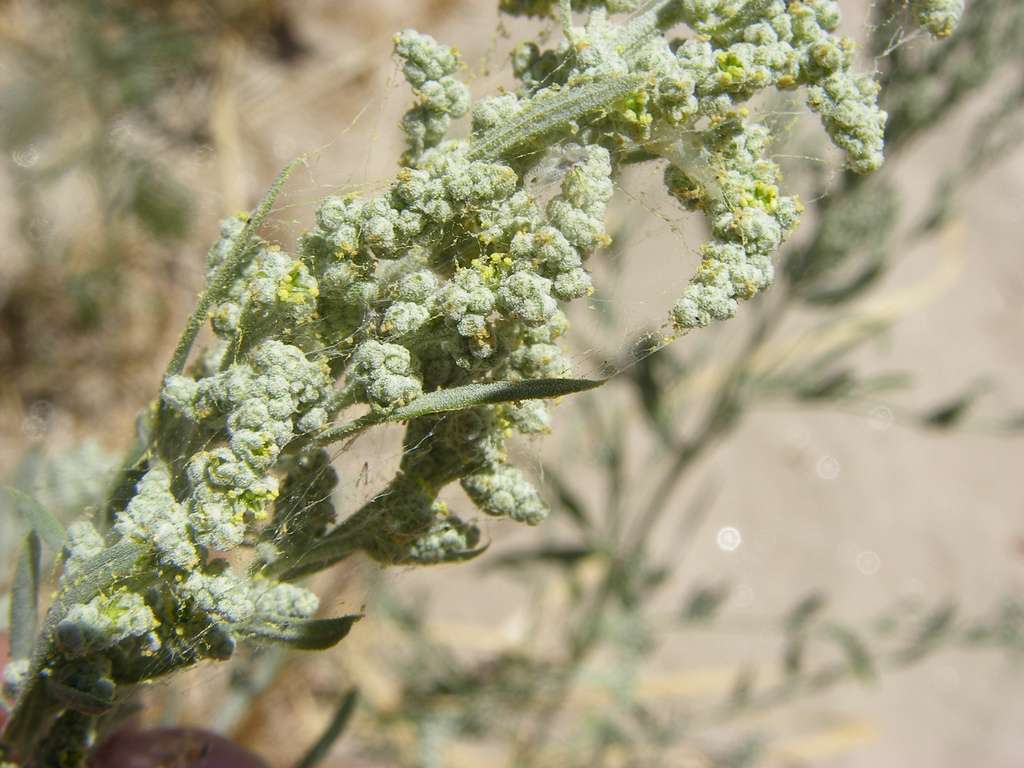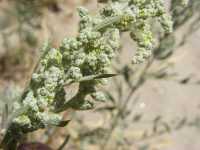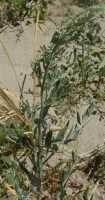Plants annual. Stems erect to ascending, much-branched, 3-10(-15) dm, ± glandular-pubescent. Leaves aromatic, distal leaves sessile; petiole to 18 mm; blade ovate to oblong-lanceolate or lanceolate, proximal ones mostly lanceolate, 2-8(-12) × 0.5-4(-5.5) cm, base cuneate, margins entire, dentate, or laciniate, apex obtuse to attenuate, copiously gland-dotted (rarely glabrous). Inflorescences lateral spikes, 3-7 cm; glomerules globose, 1.5-2.3 mm diam.; bracts leaflike, lanceolate, oblanceolate, spatulate, or linear, 0.3-2.5 cm, apex obtuse, acute, or attenuate. Flowers: perianth segments 4-5, connate for ca. 1/2 their length, distinct portion ovate, rounded abaxially, 0.7-1 mm, apex obtuse, glandular-pubescent, covering seed at maturity; stamens 4-5; stigmas 3. Achenes ovoid; pericarp nonadherent, rugose to smooth. Seeds horizontal or vertical, reddish brown, ovoid, 0.6-1 × 0.4-0.5 mm; seed coat rugose to smooth.
Fruiting summer-fall. River bottoms, dry lake beds, flower beds, waste areas; 0-700 m; Ont., Que.; Ala., Ariz., Ark., Calif., Conn., Del., D.C., Fla., Ga., Ill., Ind., Iowa, Kans., Ky., La., Maine, Md., Mass., Mich., Miss., Mo., Nebr., N.H., N.J., N.Mex., N.Y., N.C., Ohio, Okla., Oreg., Pa., R.I., S.C., S.Dak., Tenn., Tex., Utah, Vt., Va., Wash., W.Va., Wis.; native to North America and South America, widely naturalized throughout the tropics and warm-temperate regions of the world.
Southern populations of Dysphania ambrosioides are native while those populations in the northern part of the flora area are introduced.
A highly polymorphic species of wide tropical distribution, but adventive in the temperate zones. Found mostly in gravelly and sandy soil. Specimens with fewer bracts have commonly been referred to [variety anthelminticum] whose distribution is distinctly southern. It is probably much less common in the state than [variety euambrosioides].
Indiana Coefficient of Conservatism: C = 0
Wetland Indicator Status:
Annual or short-lived perennial herb to 1.5 m tall
Stem: upright, branches ascending.
Leaves: alternate, short-stalked, to 12 cm long, lower leaves lance- to egg-shaped with a tapering base and pointed tip, nearly pinnate and wavy-margined to merely toothed, progressively less toothed or non-toothed upwards, with tiny yellow glands.
Inflorescence: a small, dense cluster of flowers (glomerule), which together form a long, slender, compound spike.
Flowers: greenish, stalkless, small, with five sepals and no petals. Sepals glandular. Stamens five. Styles three to four.
Fruit: one-seeded, enclosed in the persistent, incurved sepals, thin-walled. Seed horizontal or sometimes vertical, dark brown, shiny, 0.6 - 1 mm wide, thickly lenticular (lens-shaped), without margins.
Similar species: No information at this time.
Flowering: August
Habitat and ecology: Introduced from tropical America. A weed often found in the waste places of towns and cities.
Occurence in the Chicago region: non-native
Notes: Foul-smelling.
Etymology: Chenopodium comes from the Greek words chen, meaning goose, and podion, meaning "little foot," referring to the leaf shape of some species. Ambrosioides means "resembling Ambrosia."
Author: The Morton Arboretum
Malodorous annual or short-lived perennial, erect, to 1(-2) m, with ascending branches; lvs beset with minute yellow glands, the lower blades lanceolate to ovate, to 12 cm, acute, deeply sinuate-pinnatifid to merely serrate, cuneate at base, the upper progressively less toothed or entire; fls sessile in small glomerules that are disposed in slender, somewhat elongate spikes, these in turn forming terminal panicles; cal 5-lobed, not obviously glandular; styles 3-4; seeds horizontal or some of them erect, thick-lenticular, not margined, 0.6-1 mm wide, dark brown, shining; 2n=16, 32, 64. Native of tropical Amer., established as a weed in gardens, roadsides, and waste places n. to Me. and Wis.
Gleason, Henry A. & Cronquist, Arthur J. 1991. Manual of vascular plants of northeastern United States and adjacent Canada. lxxv + 910 pp.
©The New York Botanical Garden. All rights reserved. Used by permission.






